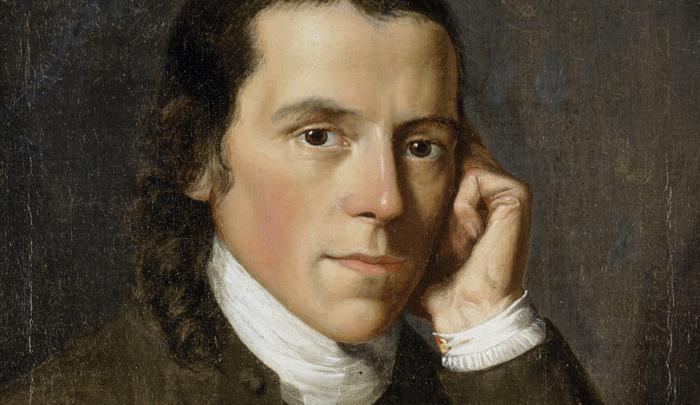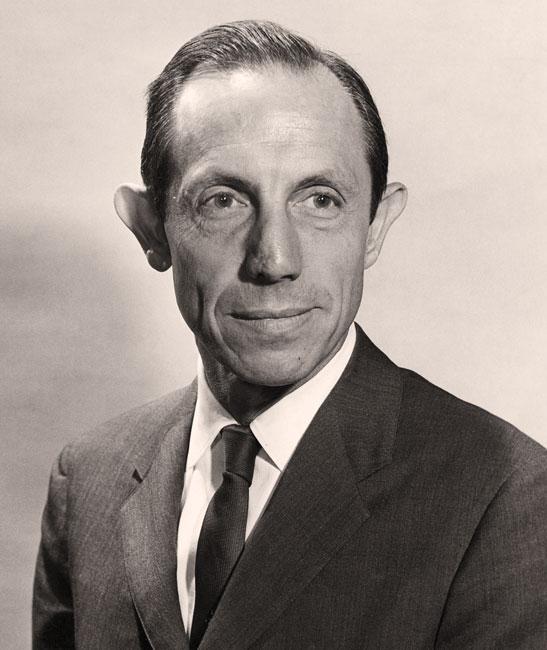They All Laughed
Harvard doctors have a long tradition of earning the last laugh by persevering in the face of skepticism
- Profile

History is filled with ill-fated schemes, from tailor Franz Reichelt’s 1912 jump from the Eiffel Tower to test his “coat parachute”—it failed—to Ford’s four-wheeled flop, the Edsel. Other innovators and theorists, though mocked in their day, have eventually been proved correct. The world, it turns out, is indeed round.
Medicine is no different. For every instance of bloodletting, lobotomy, and snake elixir, other ideas have changed human health for the better. These four Harvard Medical School physicians defied skepticism to bring us lifesaving discoveries. As the Gershwin tune concludes, “Who’s got the last laugh now?”
Benjamin Waterhouse

These days, smallpox is little more than an unpleasant memory, but for millennia, it was a scourge that felled millions of people around the world, permanently disfiguring those who survived. By 1798, British physician Edward Jenner had developed a vaccine that used cowpox, a related disease, to protect against smallpox. Despite his success in England, the vaccine was ignored in the United States.
Enter Benjamin Waterhouse. A founding faculty member of Harvard Medical School and its first Professor of Theory and Practice of Physic, Waterhouse had been educated in Europe and kept in touch with a London physician, who sent him Jenner’s report on the vaccine’s effectiveness. Intrigued, Waterhouse began a correspondence with Jenner and soon convinced him to send samples of the vaccine. Then, in a display of either an overwhelming faith in Jenner’s work or an arrogant overconfidence in his own judgment, Waterhouse carried out the first tests of the vaccine—on his five-year-old son.
Fortunately for both elder and younger Waterhouse, the vaccine worked. Encouraged, the good doctor inoculated several other relatives to, he later wrote, “convince the faithless and silence the mischievous.” In the summer of 1800, he inoculated a twelve-year-old servant before delivering him to a Brookline, Massachusetts, smallpox hospital, where he would undoubtedly be exposed to the disease. The boy remained healthy, although he did report a sore arm from the needle jab. (The doctor’s ego, too, was unharmed. Of his work, he later wrote, “I attained a triumph so complete that it is now rare to meet an American with marks of smallpox on his face….Vaccination saves millions of lives every century, like the blessing of the sun, universal and everlasting.”)
Waterhouse advocated for smallpox vaccination throughout his life, enlisting the help of then-president Thomas Jefferson. Yet his efforts were met with resistance. Critics declared the vaccine ineffective, probably the result of poor sanitation and lack of refrigeration. Or perhaps it was jealousy: Some envied Waterhouse’s European medical training and ascribed to him a condescending demeanor. Indeed, the doctor engaged in feuds with the Boston medical establishment, including another founding faculty member of HMS, Professor of Anatomy and Surgery John Warren. A sticking point was Waterhouse’s refusal to share the vaccine with many local physicians—and his demand for part of the profits when he did share it. Whether this was an attempt to ensure proper inoculation or to create a monopoly remains unclear.
Eventually, thanks in part to—and perhaps in spite of—Waterhouse’s actions, smallpox vaccination became widespread. By 1897, barely half a century after his death, the disease had been virtually eliminated from the United States; in 1979, the World Health Organization certified the disease’s eradication. A plaque on his grave credits Waterhouse for his work in vaccination and his success in overcoming “popular prejudice and distrust…[to earn] the gratitude of future ages.
Oliver Wendell Holmes, Sr.

Oliver Wendell Holmes, Sr. is perhaps best known as a poet, but his greatest masterpiece involved infection, not inflection. While an undergraduate at Harvard, Holmes began writing as a hobby; the year after his graduation, the publication of his poem “Old Ironsides” brought him national attention—and helped generate public support to preserve the USS Constitution. Soon after his graduation, he enrolled in medical school, earning his degree from HMS in 1836.
Holmes had long been a critic of the state of medicine: He railed against the practice of bloodletting as ineffective, denounced homeopathy as “the pretend science,” and decreed that if all current medications “could be sunk to the bottom of the sea, it would be all the better for mankind—and all the worse for the fishes.” At the same time, he sought to improve the conditions under which physicians worked—and under which too many patients perished. Yet his attempts at reform were highly controversial. His theory was, after all, based on the blasphemous claim that doctors were killing their own patients.
In 1843, Holmes published his essay “The Contagiousness of Puerperal Fever.” It did not meet with the same warm reception as “Old Ironsides.” In fact, the essay—in which Holmes maintained that puerperal fever, a common cause of maternal death during childbirth, was a transmissible disease—was met with skepticism. Two prominent obstetricians, Hugh Hodge and Charles Meigs, attacked Holmes’s theory, as did the doctor’s former HMS instructor, Walter Channing. Although their resistance seems outlandish today, Holmes’s essay predated Louis Pasteur’s experiments with bacteria and the germ theory of disease. Because puerperal fever didn’t affect every patient exposed to it, critics argued, it could not be contagious.
Holmes was undaunted. He collected evidence of doctor-to-patient transmission of puerperal fever, suggesting that physicians spread the disease through the blood and other body fluids that caked the very clothing they wore. In 1855, with an HMS deanship under his belt, Holmes reprinted his essay, pointedly addressing his critics in the preface: “I had rather rescue one mother from being poisoned by her attendant, than claim to have saved forty out of fifty patients to whom I had carried the disease.” This time, as medical opinion had begun to evolve, the essay garnered positive attention. Today, Holmes’s greatest legacy lies not in a poetry anthology, but in his success in advancing the concept of infectious disease—and in allowing most women to give birth without the fear of dying.
Paul Zoll

Before the 1950s, the most effective way to get a stopped heart beating again was both crude and dangerous: Cut open the patient’s chest, grab the heart, and squeeze. Cardiologist Paul Zoll sought a better approach—one that kept the patient’s torso intact and the physician’s hands relatively clean. That his method was met with horror by some is merely a testament to its stunning effectiveness.
A 1936 graduate of HMS, Zoll was working as a U.S. Army doctor during World War II when he watched a colleague remove shrapnel from a patient’s beating heart. Amazed by the organ’s responsiveness to outside contact—in this case, from a scalpel—he began brainstorming less-invasive ways to stimulate the heart.
Zoll was not the first to hope for such a solution. In 1930, cardiologist Albert Hyman, Class of 1918, had designed a machine powered by a hand crank that produced electricity. When delivered through a needle plunged into a heart, the electricity triggered beats from the stalled organ. Yet the medical community had paid this invention little heed.
Two decades later, Zoll began work on a kinder, gentler alternative: a so-called external pacemaker that relied on an electrical current outside the chest cavity to stimulate the heart. By 1952, Zoll had published studies of his creation, noting its ability to resuscitate patients in cardiac arrest. While his first patient lived just 20 minutes, another survived for 11 months following 52 hours of pacemaker stimulation.
It should have been a slam dunk. Instead, Zoll’s innovation met with a frustrating combination of physician resistance, blocked funding, and public outcry. The pacemaker, scoffed one of his colleagues, was “a toy.” Zoll was initially denied a grant by the U.S. Public Health Service, possibly because the head of the award committee had failed at similar research years earlier. And religious groups described the pacemaker as tampering with God’s will. The media did Zoll no favors. “Dead Brought Back to Life!” screamed one local paper’s headline. “Many people,” Zoll later wrote, “thought that it might be blasphemous, improper, or unethical to keep a patient alive by such artificial means.”
Undeterred by sour grapes and superstition, Zoll went on to develop the first defibrillator and heart monitor. Because he neglected to patent his creations, Zoll saw others—including fellow HMS graduate Judah Folkman ’57—refine the technology until small, implantable pacemakers became the norm. At the time of Zoll’s death in 1999, an estimated half million new pacemakers were being implanted in patients annually, saving countless lives.
Judah Folkman

Judah Folkman ’57 became a reluctant celebrity in 1998, when a front-page New York Times article quoted a colleague as declaring, “Judah is going to cure cancer in two years.” Hyperbole aside, the statement did little to acknowledge Folkman’s long struggle to prove his theory that a cancerous tumor’s growth could be halted by choking off its blood supply.
The face of cancer treatment began to change in the early 1960s, when Folkman, then at the National Naval Medical Center, noticed something curious about the tumors he was studying in the lab: They all grew to a certain size—and then stopped growing altogether. The common link, he realized, was the eventual inadequacy of their blood supply. It seemed simple, perhaps too simple. A “successful” tumor, Folkman suspected, must somehow be able to induce new vessels to grow within it, a process called angiogenesis. Disable that mechanism, and you could potentially starve the malignancy. And yet, as Folkman later admitted, “I didn’t have any idea that it would be some 30 years to try to understand the process.”
In 1971, Folkman published his first major study of angiogenesis in The New England Journal of Medicine, arguing that the process enables tiny clusters of malignant cells to become larger metastatic growths. The response was tepid at best. Folkman reported seeing researchers “laughing in the corner” when he spoke at conferences. His friend John Enders, an HMS professor who had shared the Nobel Prize for his work on the poliovirus, warned him that he would likely need to conduct dozens of experiments before he could convince the skeptics. It took hundreds.
By the end of the 1980s, those experiments—as well as scientists’ discovery of the trigger for angiogenesis, vascular endothelial growth factor, or VEGF—had begun to turn the tide. The Times’ bold prediction, of course, did not come to pass. Yet Folkman, who was the Julia Dykman Andrus Professor of Pediatric Surgery at Children’s Hospital Boston at the time of his death in 2008, left an encouraging legacy: The anti-angiogenesis drugs his research inspired have restored vision in people with age-related macular degeneration and other eye diseases.
Jessica Certain is the assistant editor of Harvard Medicine magazine.
Images: Courtesy of the Library of Congress (top, O.W. Homes); The National Gallery of Art (B. Waterhouse); Courtesy of the Albert and Mary Lasker Foundation (P. Zoll); Mark Ostow, courtesy of Children’s Hospital Boston (J. Folkman)